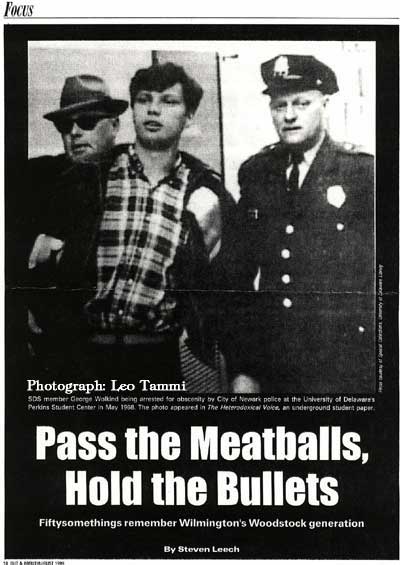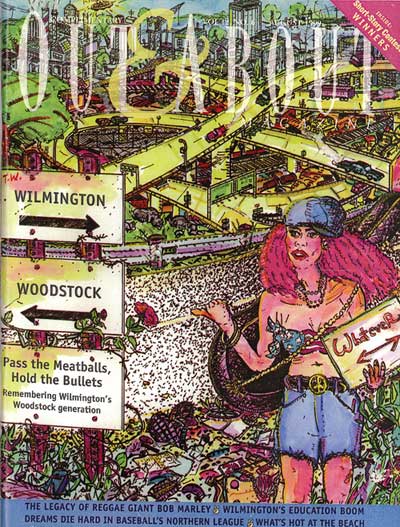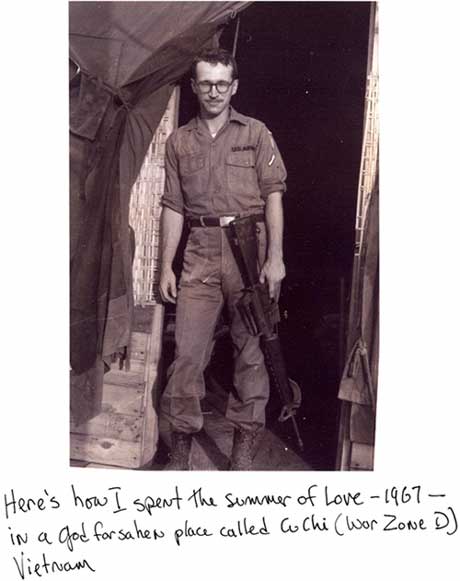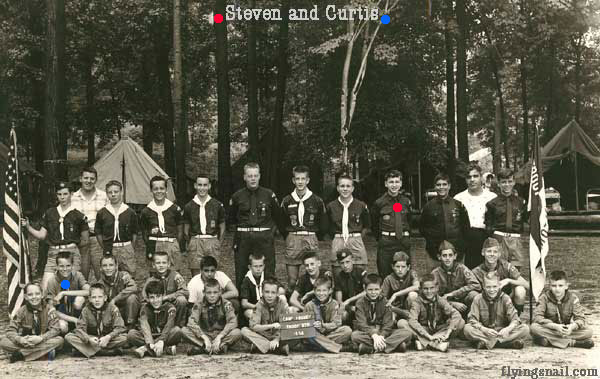
Steven Leech
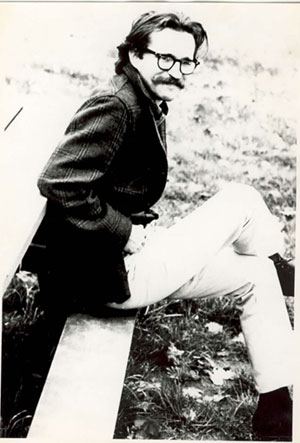
Poet, editor, and publisher Steven Leech has been active in the Delaware literary scene since the early 1970s. Leech founded Dreamstreets, a small local literary press, which first published the magazine Dreamstreets and has recently issued a number of reprints of nineteenth-century Delaware authors such as John Lofland, "the Milford Bard." Leech has promoted the appreciation of literature and literary history through publications, readings and poetry seminars, and through radio broadcasts on WVUD 91.3, where he is a radio host and producer. Leech received a 1993 Individual Artist Fellow in Literature from the Delaware Division of Arts. His own work includes the novels Raw Suck, Untime, Poe's Daughter, and Golden Star; stories and poems that appeared in Nemocolin X Press; and numerous articles for Delaware publications such as Out & About and the Wilmington Spectator.
http://www.lib.udel.edu/ud/spec/exhibits/recent/delaware.html
Hockessin Art & Book Fair, November 10, 2018
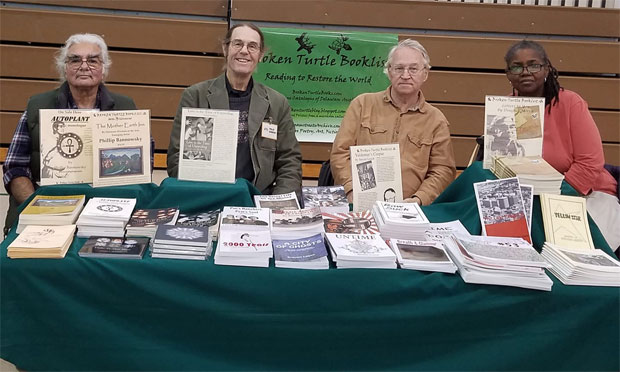
Douglas Morea ~ Phillip Bannowsky ~ Steven Leech ~ Franetta McMillian
Pass the Meatballs, Hold the Bullets
by Steven Leech
According to artist R. Crumb in ZAP COMIX #0, the '60s really began in a dime store in Jersey City in 1959 when, during a fight with Mrs. Knish, Mrs. Yahootie got hit with a meatball from out of nowhere right after a voice suddenly heralded its impending arrival The event changed Mrs.Yahootie's life. But it wasn't until a machinist for Dempster Dumpmaster was awakened by a meatball from a nightmare about the H-bomb that the metaphor took off. All across the country, "getting hit with a meatball" became synonymous with consciousness-raising.
Soon after, people in all walks of life began getting hit. Bertrand Russell got hit. Kim Novak got hit on live television while millions of viewers watched. R. Crumb claimed the story made the front cover of LOOK magazine.
Before Crumb ended up in San Francisco, where his meatball myth began, he spent his formative teenage years in the spare cultural environment of Kent County, Delaware in the late 1950s. He exorcised various demons acquired there in the pages of what were known then as "underground comics." Like the underground newspapers of that era - among them the Berkeley Barb, the East Village Other and The Heterodoxical Voice (published in Newark, Del.) - they were the voices of a counter-culture that would eventually hit its most resounding note in an event known as Woodstock. The concert that delivered the biggest meatball of all took place 30 years ago this month.
The music of Woodstock embodied more than the messages of the '60s; it embodied an entire mythos. Woodstock evolved from the "Summer of Love" in San Francisco's Haight Ashbury district and the Monterey Pop Festival that launched it in 1967. Young people were united by a shared vision of the coming new Age of Aquarius, an age that would usher in an era of cosmic love, cosmic peace and cosmic harmony. At the Woodstock Festival, a half-million people were one with the myth.
It was in this atmosphere that R. Crumb rose to prominence. In addition to illustrating the cover of Janis Joplin & Big Brother and the Holding Company's album Cheap Thrills, he is remembered as the artist who created bizarre and sometimes disturbing illustrations that were as ubiquitous as those meatballs raining from the sky. Although his meatball metaphor implied widespread change, many of the '50s demons that haunted Crumb were still lurking - mainly in the nation's inner cities, including Wilmington's.
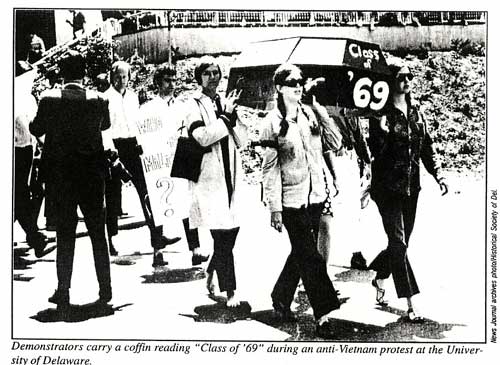
Local Agitators
Among the first in Delaware to get "hit with the meatball," in 1967, were university students Ramon Ceci and George Wolkind. The two were leaders of the local Students for a Democratic Society (SDS). Not only was the SDS known on the nation's college campuses as a vanguard of New-Left student radicalism, at the University of Delaware it was the leading force of a coalition called Student Power that elected Ceci to the Student Government Association presidency in 1968.
Primary issues on campus at the time were the Vietnam War and the university's compulsory, two-year Reserve Officers Training Course (ROTC) for males. Freshman and sophomore men also were not allowed to let their hair grow long, or, as they put it, "couldn't let their freak flags wave." The other big issue, as on other campuses nationally, was free speech, especially against the draft, the War and the powers that waged it.
While Ceci became the elected student leader, Wolkind became the firebrand of local youth radicalism. Witty in public speech as well as in articles in The Heterodoxical Voice, Wolkind was a charismatic leader whose abilities included spellbinding oratory that rang with new truths and a spontaneous joyous humor.
"George was a major influence on me," says Newark resident Desmond Kahn, a former student radical. "We debated the war because after high school I wasn't sure whether I wanted to join the military or go to college. My discussions with George led me to become very disturbed about the war. After studying the issue I came out in opposition to it."
Like-minded students staged "sit-ins" and "teach-ins" and took over university buildings to protest the draft and the war. The Heterodoxical Voice was the voice of youth radicalism and counter-culture, as well as a champion of free speech. One memorable free-speech issue erupted when a leaflet promoting a "teach-in" used a slogan that later turned up in the Jefferson Airplane song "We Can Be Together" from their 1969 album, Volunteers. That slogan got Wolkind and three other student signatories, including Ceci, arrested for obscenity! "The Great Obscenity Bust" led to the case getting thrown out of court, but not until after the battle lines were drawn.
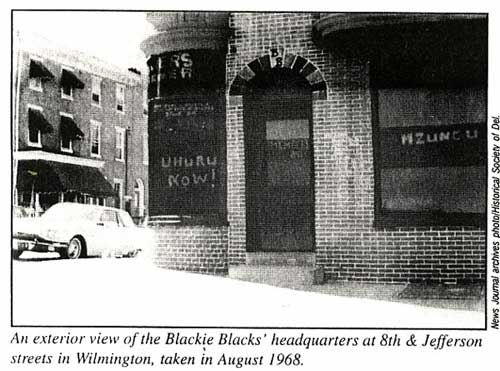
Marching Toward Wilmington
Battle lines were drawn in Wilmington in a big way when Delaware Governor Charles Terry called in the National Guard to occupy the city after the riots that followed Martin Luther King's assassination in '68. In spite of all the fear and rage, the meatball hit there, too.
The Heterodoxical Voice addressed the issues of ghetto life for its Newark and Wilmington readers from what looked like a war zone in Wilmington, where youth established their own organization. It was called Wilmington Youth Emergency Action Committee. Wilmington's Black newspaper, The People's Pulse, initially edited by Ralph Morris, published continuously during the National Guard's nine-month occupation, courageously keeping black residents in touch with community issues. Among the youth leaders in Wilmington were Ramon Ceci and George Wolkind.
"We were trying to work out a peace among the gangs by organizing them," Wolkind remembers. "We worked with a teen center in Southbridge to channel their energy into politics."
And then there were the bullets. Another urban teen center had born the brunt of the riots. Called "Blackie Black," it was located at 8th and Jefferson in a section of Wilmington called "the Valley" - between Washington Street and the new 1-95. Founder Leonard E. Flowers was considered a West Center City folk hero. But a month into the National Guard's occupation, in May 1968, Flowers was shot dead by a man from East 13th Street. A memorial service and rally at 7th and Jefferson was attended by 400 people, in spite of the very real possibility that large crowds might make the National Guard nervous.
After the rally, roses were left behind, as well as signature jackets from the various rival youth groups in the area. The meatball hit everyone that day to counter the single bullet that ended the life of a man whose primary goal was to get people to communicate.
The youthful tumult of 1968 finally boiled over in the dog days of summer at the Democratic National Convention in Chicago. Youth demonstrations wrested public attention away from the convention floor, and a "police riot" witnessed by millions on television brought some of the wounded back to Newark. Wolkind, who was among the demonstrators, gave a moving account and analysis in a talk at the Phoenix coffeehouse, located then on Orchard Road.
In Wilmington, both Wolkind and Ceci worked to elect local blacks to public office. "Ray Ceci and I went down to be poll watchers. Ceci almost got into a fist fight with some party machine goons who tried to keep us away. I told Ceci it'd be better to die in Madrid - somewhere glamorous," Wolkind remembers, laughing.
As 1968 gave way to 1969, the atmosphere turned both grim and strange. Whispers of guerrilla warfare began to percolate up through all the protests and demonstrations. Street theater had not yet taken on the harder edge of what would become known in Newark as guerrilla theater; the day-glo orange and paisley themes of peace and love still colored the activity.
In an incident that reportedly is still a part of UD folklore, a street-theater event was staged by some local "freaks" during the inauguration of university President E. A. Trabant. Wearing whiteface and the traditional black of the mime, Newark resident Manuel Grink and four companions (one a former U.S. Navy Seal who's now rumored to be living on the edge of the desert somewhere out West) converged that spring day in 1969 upon the solemn inaugural procession.
"We were not being disrespectful. I think we were making a quiet statement," remembers Carol Jeanne Gaumer, now a marketing professional at Winterthur. "We mimed the procession as a kind of gentle mockery. I think we were expressing the hope that a new president would mean a more liberal perspective."
"No one paid any attention to us at the time," Gaumer adds. "I'm amazed anyone remembers."
Grink, now a retired public school employee, suppresses a smirk. "The one thing that got me is that we wore white face so we'd all look the same, as much as to keep us from being recognized."
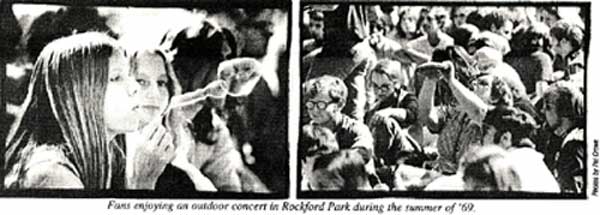
In Deep
Meanwhile, George Wolkind and Ramon Ceci had parted amicably and followed different paths. After graduating in 1968, Ceci worked for a while as a longshoreman on the Wilmington waterfront and continued to do political work in Baltimore and Philadelphia until he died in February 1999 of cancer. In 1969, Wolkind joined the Weather Underground, a militant outgrowth of SDS whose name was derived from the Bob Dylan lyric, "You don't need to be a weatherman to know which way the wind blows." (Subterranean Homesick Blues)
"SDS wanted an organization with swagger and panache," says Larry Newbold, a campus organizer for SDS in the late '60s and now a cashier working in Wilmington. The Weathermen were highly confrontational, garnering a reputation for breaking up political gatherings with an urgency generated by a'60s version of political correctness. Their attitude was unequivocal: You're with us or against us. Coming dangerously close to committing guerrilla warfare, they lived communally and in poverty in order to identify with America's disenfranchised.
"We ate chicken and rice every fucking day, and on the weekends the women would go into the supermarkets with their big pocketbooks and steal steaks," recalls Newbold.
"I remember some of the Weather Underground showing up at my door claiming the right of hospitality based on revolutionary kinship," adds Phillip Bannowsky, an autoworker who still lives in Newark. "They had this guy named Oliver Fish, who was about 17 and wearing a sweater about three sizes too small. He showed me postcards of Vietnamese war heroes. His hands were bony and blue. He went to the fireplace, pulled out a stack of train schedules, and tore them up into tiny pieces, saying over and over, 'Security is such a hassle."'
By mid-1969, paranoia had set in to challenge the hegemony of peace and love. But the Weathermen eventually lost what little support they had with mainstream America and acquiesced to the forces of law and order.
"Nothing like bullets flying around your head to make you crawl back into your white-skin privilege," was the way Newbold put it.
The infusion of paranoia into the counter-culture also contributed to some people assuming different identities. In some ways, the infusion even altered reality.
"I felt like bullets would go right through me," the Gentle Gargoyle was reported to have once said about his own state of being. The Gentle Gargoyle was one of at least three members of the " 1,000 Club," locals who had tripped on LSD no less than 1,000 times. The two others were the Hipster Merlin, who now lives in California, and Allan Murphy, who jumped off the Delaware Memorial Bridge in the early '70s, believing his own sense of altered reality would enable him to survive the feat.
The Hipster Merlin was northern New Castle County's answer to Neal Cassady of Beat Generation fame. Like Cassady, he had a magnetic personality and, despite lack of a college
When they learned of plans to dam White Clay Creek to create a large reservoir in the area, many of those starry-eyed freaks got politicized fast.
education, could carry on a revelatory discussion on the subject of Herman Hesse's Magister Ludi while flying down the highway at breakneck speed in his old Plymouth.
According to a story told by Martingflas Reenban, a retired government worker now living in suburban New Castle County, one afternoon a bunch of stoned-out freaks were tearing down Route 40, with Merlin pushing the Plymouth up to 80 mph Approaching Route 72 near Newark, they spotted a tractor-trailer slowly making its way across the intersection. Hitting the brakes would have been as futile as not hitting them; a violent impact was imminent. The Hipster Merlin stomped on the gas instead. It was the only other choice, a purely cosmic one. Afterwards, the occupants of the Plymouth reportedly swore that instead of impact, the molecules of both vehicles meshed in one karmic instant. The Plymouth passed right through the tractor-trailer unscathed and continued flying down the highway toward Elkton at roughly 100 mph!
"Shoot the projectionist!" the Hipster repeated over and over. (Like Neal Cassady, he was trying to catch up to his own movie. He believed that reality was only a projection of energy to which the body's senses merely react. And that whatever occurred previously had been set in motion by a "projectionist.")
If there is evidence of this bizarre sequence of events, it can be gleaned from The Black Angello Manuscript, which still exists and is stored in the Special Collections section in UD's Morris Library.
The document originated, however, in an Ivy Hall apartment, where it was compiled by Reenban and his two brothers, along with the Hipster Merlin, Murphy, Grink, and other assorted freaks and burned-out, New-Left casualties. It was composed on a nearly nightly basis in a round-robin fashion, helped along with a hearty infusion of Boone's Farm apple rot-gut, hashish and other psychedelics. The result was around 50 pages of visionary poetic exposition that included literary, occult, and sidereal references molded into a surreal plot that resembled Amos Tutuola's The Palm-Wine Drinkard, or stories told by Carlos Castenada.
Wasting Away in Hippyville
That Ivy Hall apartment was not the only tripped-out scene. Other crash pads in Newark had names like "The Tower," "20" and "Stately Page Manor." The most notorious was a rundown Victorian frame house dubbed "The Chateau." It was located on remote Yeatman's Mill Road, a country lane that dead-ended in Pennsylvania, just west of Corner Ketch, Delaware.
Coupled with the obvious jurisdictional hassle, having only one way in on a road that was hardly ever used gave the freaks and crazies who crashed there a feeling of security and the license to get as "far-out" as they possibly could.
"There was an overlap of personalities," explains Reenban, attempting to lend some sense to the scene, "between those using psychedelics to expand their consciousness - the legitimate 'heads' like Rostulos (Reenban), the Hipster Merlin and Manuel Grink - and those into thrill-seeking. The latter were using the more dangerous 'bucket chemistry' like STP, meth, ludes and just plain junk."
The Chateau was also at the edge of what was known then as "Trollheim," an obvious reference to the works of J. R.R. Tolkien, which were popular in the '60s. Generally, Trollheim was the rural area, predominantly made up of virgin woods, that straddled the White Clay Creek Valley between Landenberg, Pa. and Newark's northwest outskirts.
"Kids living in the enclosed and stressful conditions in Newark occasionally needed to get out into open space and closer to nature," explains Carol Jeanne Gaumer. "Trollheim also wasn't consistent in time and space."
Gaumer's reference is to Trollheim's penchant for enchantment. One could easily lose track of time there, or discover a stimulating environment that could never be found again. It was a good place to use psychedelics, which led some to experience even more pronounced space distortions and time warps.
When they learned of plans to dam White Clay Creek to create a large reservoir in the area, many of those starry-eyed freaks got politicized fast. Cries of public protest ensued, including articles in The Heterodoxical Voice, and the issue became heated. For whatever reason, the plan was scrapped, but not before the issue played a major part in the launching of the local, environmental movement. The pristine environment of Trollheim survives today, much as it was in the late '60s.
The Legacy
As the decade ended, the growing craziness at the Chateau began to mesh with the counter-culture grind setting in in Newark. The phenomena was accelerated when the Chateau burned down, a casualty of thrill-seeking combined with nightly fires set in a pit in the basement.
In Newark, in another bizarre incident, 1,000-Club member Murphy, only a couple of years out of Newark High, was listening to Bob Dylan sing "Any heart can stumble and fall into some muddy lagoon, even when it's 9 below zero and 3 o'clock in the afternoon."
Murphy looked at the clock. It was 3 o'clock in the afternoon. The synchronicity sparked a spontaneous reaction: He found one of his father's revolvers and emptied it of all the bullets. Murphy was, after all, a pacifist. He got dressed to look like a real square, complete with a hat Sinatra would wear. Then, tucking the revolver into his pocket, he made off for the closest liquor store, on Elkton Road.
The guy behind the counter put the tray from the cashier drawer firmly on the counter when Murphy pulled the empty gun on him. For expediency, Murphy set the gun on the Counter so he could yank the money out of the tray - maybe $200. The clerk picked up the gun, pointed it at Murphy and started squeezing off shots. Click, click, click. Murphy pocketed the cash, tipped his hat, grinned and danced out the door. But soon he was running.
Eventually Murphy was driven out of state on the lam, with the Hipster Merlin behind the wheel. At an obscure house somewhere in the space distortions of Pennsylvania, Murphy autographed 13 one-dollar bills as souvenirs for his fans. Then, in a legal stand-off, he eventually beat the rap.
Murphy's schtick and subsequent fatal leap from the Delaware Memorial Bridge set the stage for a visit to Newark from Ken Kesey. Besides being the author of One Flew Over the Cuckoo's Nest, Kesey was notorious for traveling around the country in a psychedelic school bus called "Further" with cohorts known as the Merry Pranksters. Stories of their LSD-driven madness aboard the bus, driven by Neal Cassady, were told in Tom Wolfe's The Electric Kool Aid Acid Test.
Someone blinked and noticed it was 1972. Real bullets from the Ohio National Guard had already killed four student war-protesters at Kent State, and Ken Kesey was in Newark to inspire students and youth to take over. They had the numbers. They could do it, Kesey claimed. The question was, could the peace-and-love harmony of the '60s survive '70s uncertainty?
At the Ken Kesey event in UD's Mitchell Hall, February 28 - the day before "Leap Day" the 29th - George Wolkind was nominated from the floor to run for mayor of Newark.
Wolkind transformed the political views developed from New-Left radicalism into policies for his campaign. But there were more nitty-gritty issues that delayed Wolkind's getting on the ballot - like the 19th century throwback requirement that candidates for office be property owners. Wolkind and other youth candidates bought plots in local cemeteries to get hold of a deed. But it was too late.
Wolkind's next chance to run for mayor was April 1973, a bad fold in time in the normal November, even-numbered-year election cycle. Also setting the stage for disaster was the death of Eddie Day in February 1973.
At the time, Day was the lead singer in a Newark-based band called Snakegrinder. A legacy of the 1968 band Joint Chiefs, Snakegrinder sounded like a blend of The Grateful Dead and The Band. It was a local counter-culture rock band that played its own version of the Age-of-Aquarius vision.
Many of Eddie Day's friends, Wolkind among them, were concerned. "Eddie, you're killing yourself," Wolkind told him. Eddie had begun to consume too much bucket chemistry.
"Yeah, I know," was Day's reply.
On the last day of his life, Eddie Day had spent some hours in the Deer Park Tavern in Newark. Someone said he'd taken a bunch of Quaaludes earlier. That was enough in itself to fold space and string out time.
A little after 1 a.m., Eddie and three others, a guy named Kool Aid and two women, left the Deer Park, They piled into Eddie's car. It was his intent to swing around to Elkton Road by using the little access street between the Wonderland Music Store and the B&O Railroad tracks. But space was folding and the distortion caused Eddie to turn up the railroad tracks instead, where his car got helplessly straddled. The lights of a northbound freight appeared on the short horizon.
Everyone piled out of the car. There was enough strung-out time to stop the train, so Eddie ran only a short distance up the track to wave the train down. He was successful. The train had to stop, but not before taking out Eddie and his car.
"Eddie always said he was gonna leave on a southbound freight," Wolkind commented recently while recalling the event. "He just got the direction wrong."
Around the time Wolkind lost in his run for mayor by a landslide, he was enjoying a quiet moment with his girl friend Jenny in their Newark apartment. Wolkind's two clogs, Meatball and Son of Meatball, had also been quiet when suddenly both dogs began howling, greatly agitated. There in the corner was a strange orange light. Both dogs were in a panic.
A voice spoke to Wolkind from the light. It was Eddie Day.
First, Eddie assured Wolkind that he was okay and in a "good place." Then he told Wolkind he'd be replacing him as lead singer of Snakegrinder. Wolkind replied that would be impossible. He'd never sung in a band before, and never even remotely considered the likelihood. Before Wolkind could become more convincing, Eddie had gone.
According to Wolkind, a year to the day after the apparition of Eddie Day appeared, two members of Snakegrinder asked him to join their band.
Snakegrinder cut a single album in 1977 with George Wolkind singing lead on two songs. Shortly afterwards, the band dissolved into the late '70s, their role in the local version of '60s mythology intact.
Today, Wolkind lives in Colorado Springs, where he is collaborating on a book that will detail his experiences with extraterrestrials. Like many who participated in the earth-shaking events of the '60s, he moved on. But not without holding on to certain principles.
Others have sold out and betrayed those same principles. Some have died, and some have disappeared. Some have conveniently forgotten, others refuse to talk. Many wish the meatball would fly again and hit a few choice targets. Ideals die hard.
But R. Crumb's meatball would say, with a hard wink and a mean grin, as it did in that last cartoon panel of ZAP #0, "Meatball doesn't work that way."
Boptime - with Even Steven
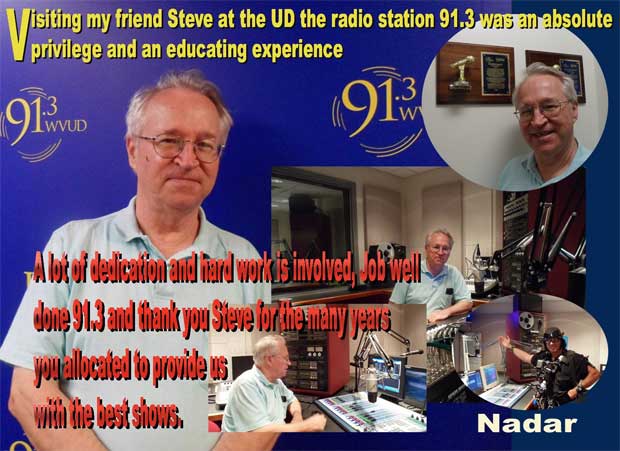
Steven Leech photograph by Nadar Assawah
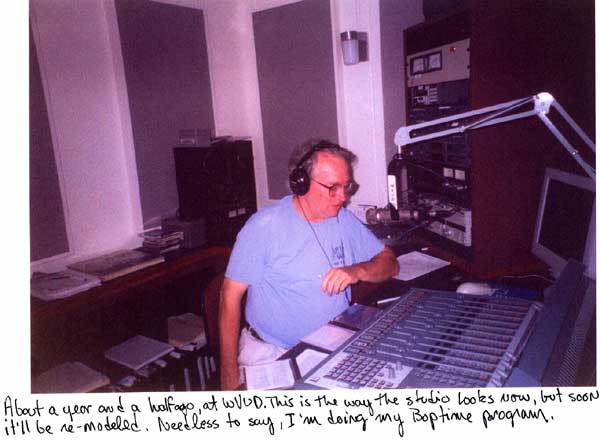
Saturdays - 6-10 am Eastern / 3-7 am Pacific
Streaming Link [Use links on left for WVUD LIVE]:
WVUD 93.1 Internet Streaming - http://www.wvud.org/listen_online.htm
[Note: For Summer Schedule - Please check WVUD Program Schedule at a Glance]:
http://www.wvud.org/program.htm
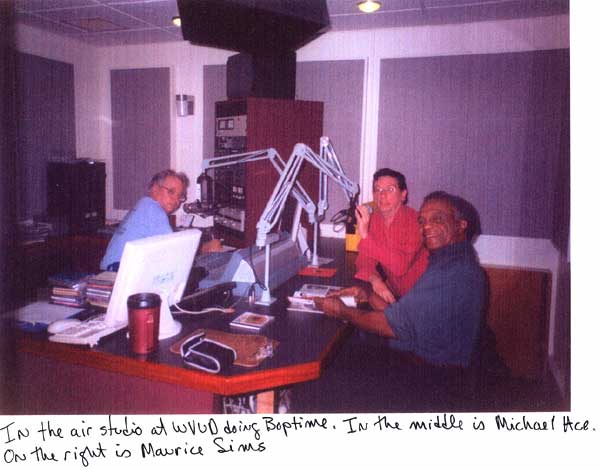

Dreamstreets
Updated 201801.12:
Steven has provided Genesis and Harbringer.pdf; part of Dreamstreets #56, located at:
http://www.dreamstreetsarchive.com/
Updated 201506.16:
Dreamstreets is broadcasting this summer at 1pm (eastern time) every Monday, until the end of August, to help promote an exhibit: "Dream Streets: Art in Wilmington 1970 – 1990" at the Delaware Art Museum, opening on June 27, 2015. Related sites & materials: Broken Turtle Blog and Broken Turtle Booklist
Many Delaware authors and poets from the past have interacted with such literary luminaries as Edgar Allan Poe, Mark Twain, Paul Laurence Dunbar, Hart Crane, Edmund Wilson, F. Scott Fitzgerald and others, and have been published by some of America's most notable publishing houses. Yet, this history of Delaware's literary past is a kind of a secret history of Delaware's cultural legacy. Dreamstreets 26 will reveal this secret history as well as suggest why and how it has been obfuscated.
For thirty years, the Dreamstreets project showcased progressive artists, photographers, and writers of the Delaware Valley. Conceived by John Hickey and a cohort of visionaries in 1977 and carried forward under the executive editorship of Steven Leech, Dreamstreets appeared almost continuously in print, radio, and television until its last issue, #50, in 2006. In this archive, we present to you a beautiful record of the most vital—if often marginalized—cultural productions of an era. Provided as an educational service. Individual works may be subject to copyright protection..
Previous Dreamstreets have been archived here: http://www.dreamstreetsarchive.com/
Broken Turtle Books LLC
Broken Turtle Books LLC is a publisher of contemporary and historical works by Delaware Valley authors. The company was formed by a group of writer/editor/publishers who have been part of the Delaware literary scene for four decades. Most of us have been associated with Dreamstreets Press, which published Dreamstreets Magazine, produced radio programs on WVUD 91.3 FM (University of Delaware), a television clip on WHYY TV (Wilmington/Philadelphia), and founded the Second Saturday Poetry Readings at various venues in Wilmington, Delaware.
The Turtle is the totem of the Leni Lenapi indigenous culture, native to the Delaware Valley before their virtual extermination. North America is often referred to as Turtle Island by Native Americans generally. In some Asian cultures, the turtle's shell represents heaven and earth bound together. Whether it is Delaware, North America, Earth, or Heaven, our world is broken. Broken Turtle Books aims to reclaim the world that should have been.
Books by Steven Leech

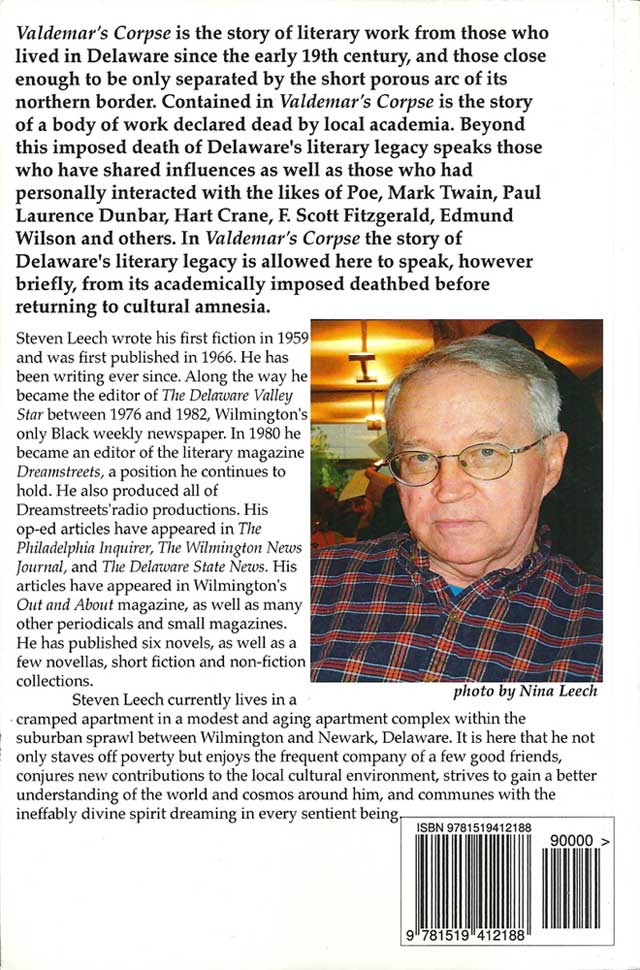
Valdemar's Corpse by Steven Leech
[Click above images for larger picture]
"Valdemar's Corpse" is the story of literary work from those who lived in Delaware since the early 19th century, and those close enough to be only separated by the short porous arc of its northern border. Using standard exposition, literary reviews from others, fictional portrayal, and the actual words from the literary artists themselves, in "Valdemar's Corpse" is the story of a body of work declared dead by local academia. Beyond this imposed death of Delaware's literary legacy speaks those who have shared influences as well as those who had personally interacted with the likes of Poe, Mark Twain, Paul Laurence Dunbar, Hart Crane, F. Scott Fitzgerald, Edmund Wilson and others. In "Valdemar's Corpse" the story of Delaware's literary legacy is allowed here to speak, however briefly, from its academically imposed deathbed before returning to cultural amnesia. ~ Available at Amazon
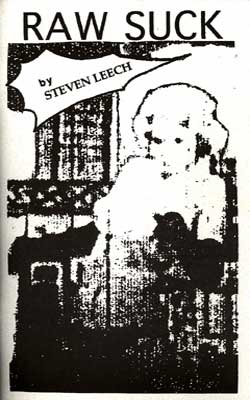
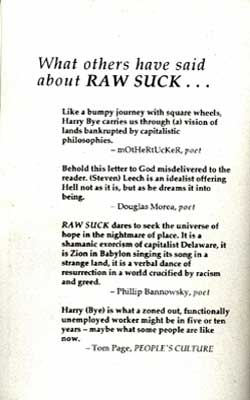

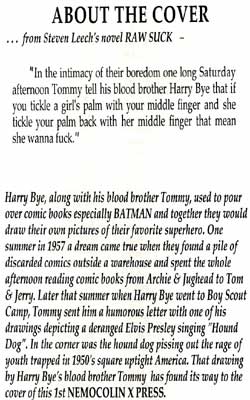
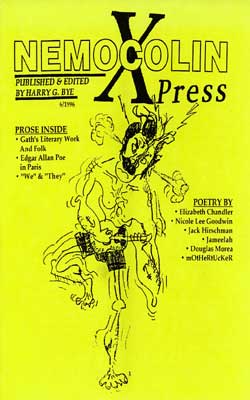
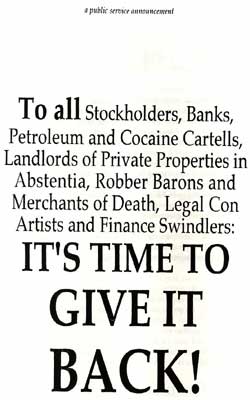
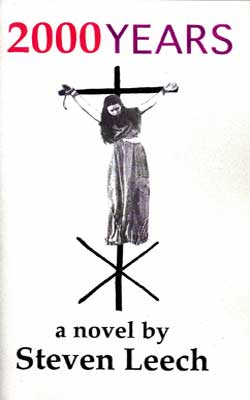
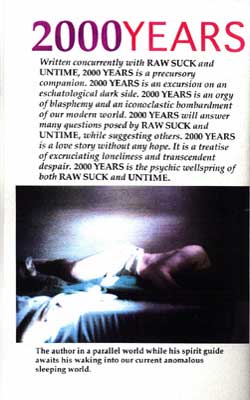

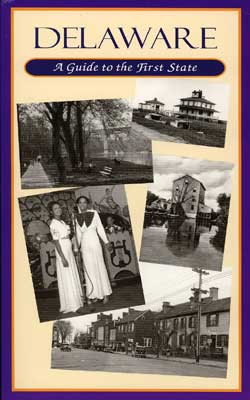
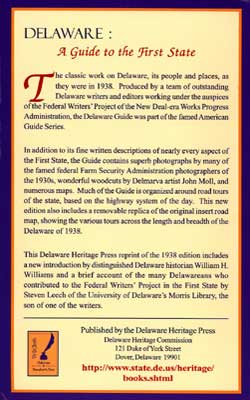
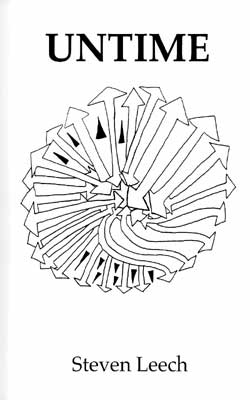
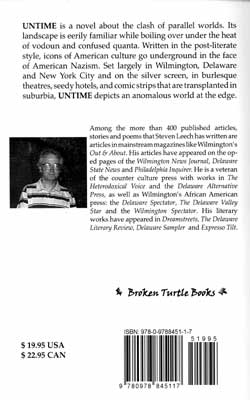
A Man Out of Time
Local Author's New Book UNTIME Searches for the Truth In UNLIKELY WORLDS
[201709.13] Steven provided a reading of the first two chapters of his novel UNTIME
Click to listen to: UNTIME1st2chapyers.m4v in new tab or window.
[201710.30] Steven has provided a second installment reading of his novel UNTIME
Click to listen to: UNTIME2ndinstallment.m4v in new tab or window.
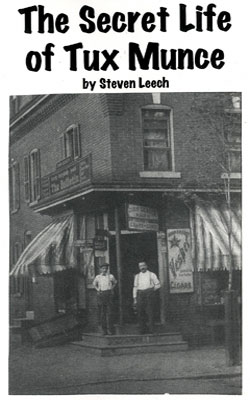
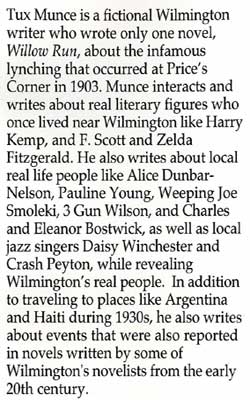
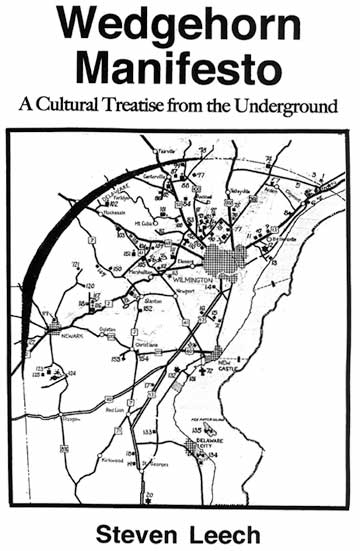
Wedgehorn Manifesto
A Cultural Treatise from the Underground
by Steven
Leech
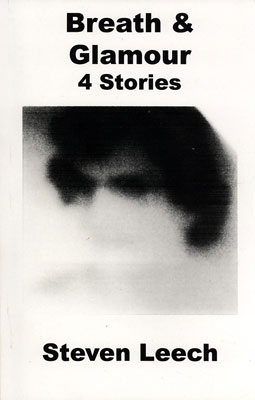
Breath & Glamour: 4 Stories
by Steven Leech
Opening Story: Friend From Venus by C. Spangler

PINHEAD Number 7:
An Expatriate Amoung the Branches:
A Delaware Artist Finds Success In Europe
by Steven Leech
Broken Turtle Blog
LITERATURE AND POLITICS FROM A MICROCOSM CALLED DELAWARE. HERE ALL THE MULTIFACETED PLAYERS ACROSS THE GREAT CAPITALIST CONTRADICTION ARE REDUCED TO A FEW ACTORS: A HANDFUL OF BANKING AND CHEMICAL OLIGARCHS SQUATTING IN CHÂTEAUX, A STABLE OF ARTISTS DOWNWIND WHO EITHER TAKE INSPIRATION FOR AMNESIA AND ROSES OR TAKE A STAND, CHALLENGING THE LIVING TO REPAIR A POLLUTED WORLD.
http://brokenturtleblog.blogspot.com/
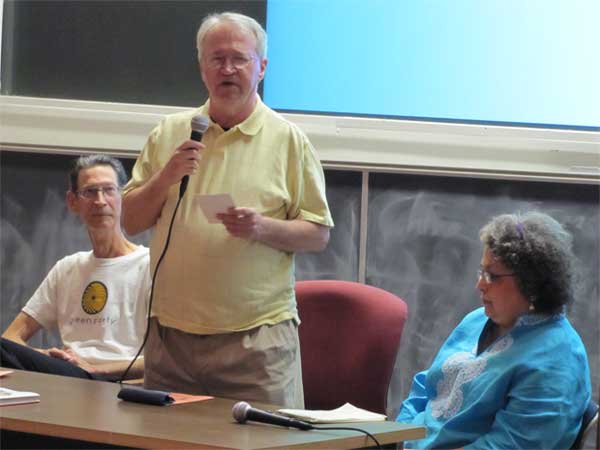
Steven Leech - Panel Discussion on '60s - University of Delaware - May 2010
The Legends of Wilmington Jazz
Today's (August 21, 2012) Legends of Wilmington Jazz will be the final broadcast as a summer replacement. I'll be beginning the broadcast of the entire series on a monthly basis during the 7am hour every second Saturday, right before Boptime's "Clifford's Corner" segment, i.e., beginning September 8th. - Even Steven
Jazz musicians from Wilmington, Delaware have performed and recorded with many of America's greatest jazz artists for over the past 70 years, and some of them have reached legendary status in our national jazz canon. This summer (2012) on every Tuesday afternoon at 1 o'clock eastern time on WVUD.org you can learn about Wilmington's unique jazz legacy on The Legends of Wilmington Jazz. It's one of Delaware's proudest contributions to American arts and culture. - Listen-On-Line - WVUD fm
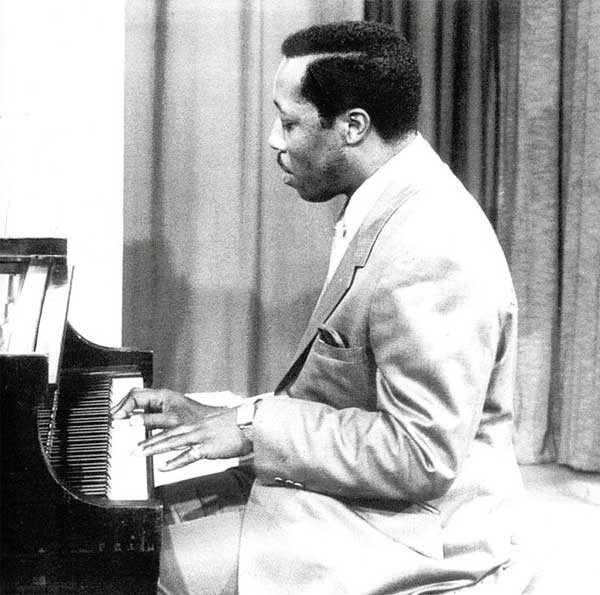
Legend of Wilmington Jazz, Gerald Price recorded with Sonny Stitt, Milt Jackson and Richie Cole.
The Legend of Wilmington covers 70 years of jazz produced by such artists from the past and present as Clifford Brown, Lem Winchester and Betty Roché to Ernie Watts and Matthew Shipp. Works of others who had produced jazz in Wilmington will be heard, along with some rare recordings.
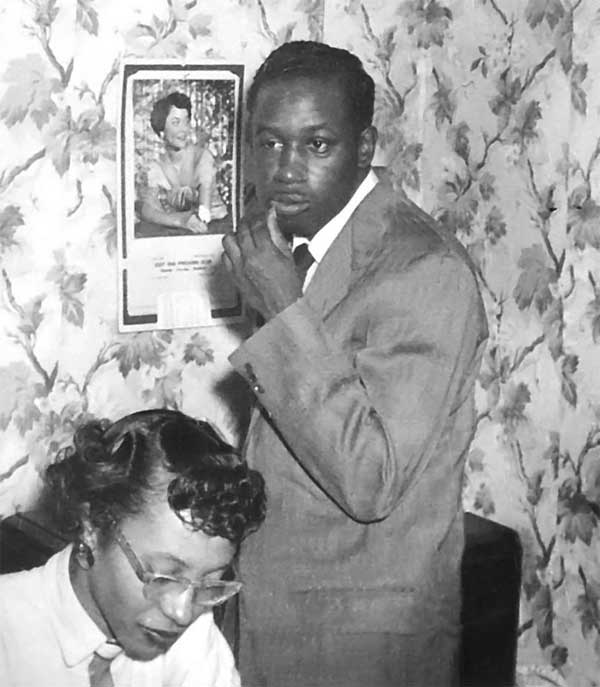
Legend of Wilmington Jazz, Clifford Brown
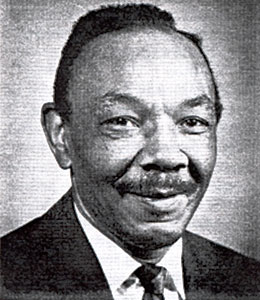
Legend of Wilmington Jazz, Boysie Lowery
Boysie Lowery not only was Clifford Brown's music teacher, but he mentored nearly every jazz artist to have come from Wilmington. A rare recording of Boysie and Clifford Brown playing together will be heard as part of The Legends of Wilmington Jazz.
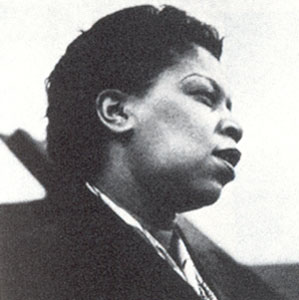
Legend of Wilmington Jazz, Betty Roché
Betty Roché was born in Wilmington in 1920. She was a member of Duke Ellington's band in the early 1940s and early 1950s, and first performed with Ellington at his Carnegie Hall concert in 1943. Because she recorded only one commercial recording with Ellington, all other Ellington sides will be rare recordings. She also recorded three solo albums in the 1956 and the early 1960s.
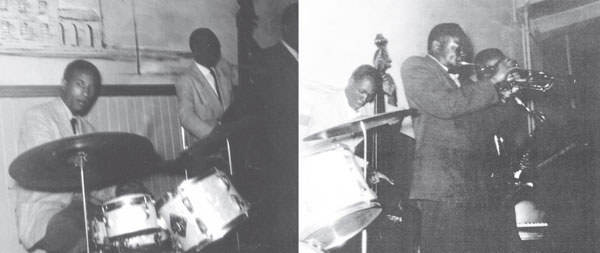
Composite photo(s) of Clifford Brown-Max Roach Quintette performing at Wilmington's Club Baby Grand
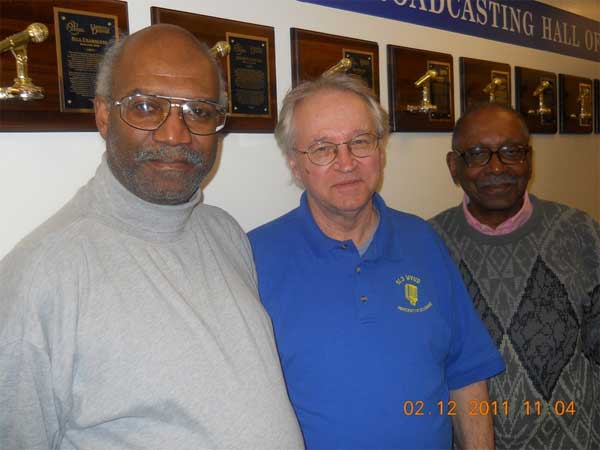
Two regulars who join me on 'Clifford's Corner' on Boptime. Larry Williams is on the left and Bob Fleming is on the right.
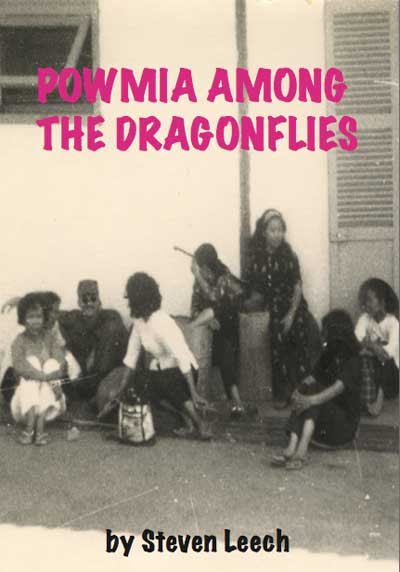
Powmia Among the Dragonflies
a Vietnam War novel by Steven Leech
CLICK TO READ PDF NOVEL
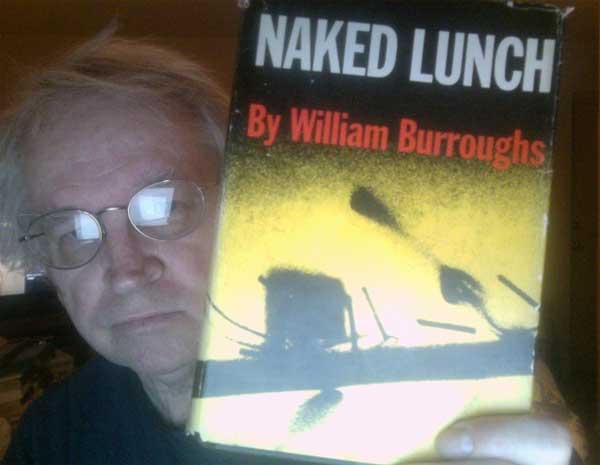
Steven Leech with one of his prize possessions ... a copy of the 1959 original first edition book, Naked Lunch by William S. Burroughs
Delaware Rock & Roll Hall of Fame
History of Rock n’ Roll in Delaware
by Steven Leech
Old Neighborhood Friends
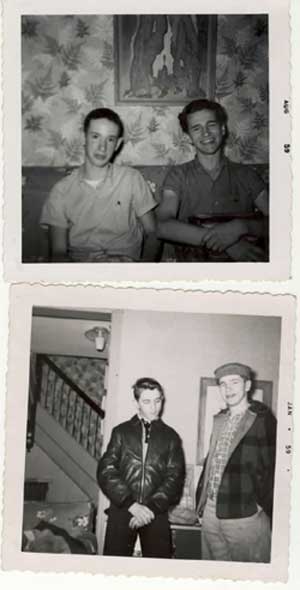
Top Picture
Jonathan Bragdon & Steven Leech
Jonathan has a page at: http://bragdon.nl/
Bottom Picture
Joe Malanga & Steven
Leech
Live from The Nomad Bar, Richard interviews Brenda Smith & Lisa Cunningham from The Crystal Center Jazz Banquet, Steve Leech [17:00 into video] of WVUD, and Tonya Phillips of the Mayor's Office with Harry Spencer Booking manager of The Nomad/Saxophonist:
http://www.ustream.tv/recorded/13988814
